|
|
|
Sort Order |
|
|
|
Items / Page
|
|
|
|
|
|
|
| Srl | Item |
| 1 |
ID:
168819
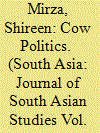

|
|
|
|
|
| Summary/Abstract |
This article explores the spatial politics of situating slaughterhouses at the margins of Mumbai city enacted by the sanitary civic state and the caste labour of the butcher community. While the sanitary state mobilises colonial discourses of sanitation that deem animal slaughter unhygienic and so needing to be located at the shifting periphery of the city, an ethnography of the Muslim sub-castes of mutton and beef butchers suggests that animal slaughter is a form of caste labour that involves cultivating hereditary skills of working with flesh, bone and blood, which the Mumbai butchers refer to as ‘karigari’ (artisanship). Their caste labour is resisting the reconfiguration of the meat trade, which they view as fragmenting the community’s control over their labour. By bringing theories of urban space, state and caste among urban Muslims into the conversation, the article describes the ways in which scientific and communal ideas of sanitation are consolidated along a continuum. It also describes the ways in which caste and religion condense along an axis to form analogous structures that are deployed by the beef and mutton butchers to resist these spatial shifts.
|
|
|
|
|
|
|
|
|
|
|
|
|
|
|
|
| 2 |
ID:
145041
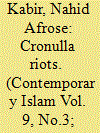

|
|
|
|
|
| Summary/Abstract |
On 11 December 2005 at Sydney’s Cronulla Beach about 5000 Australians, mostly young men from Sutherland Shire, wrapped themselves in Australian flags and asserted that Cronulla Beach belonged to them through abusive language against Lebanese Australians. Subsequently, on 12 December 2005 a group of Australians of Lebanese heritage launched an attack in reprisal. The former group exhibited their “Australianness” through an urban model based on exclusion, implying they were the West so, of course, they were better than the rest. The latter fought back, exhibiting that they also represented the West. They demonstrated their territorial rights as they asserted that the beach also belonged to them. The rather aggressive posturing of both parties raises the question of whether Muslim Australians have a place in the white imaginary spatiality.
|
|
|
|
|
|
|
|
|
|
|
|
|
|
|
|
| 3 |
ID:
140509
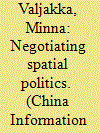

|
|
|
|
|
| Summary/Abstract |
Since the mid-1990s, growing urbanization has led to the rise of new forms, needs and sites for visual self-expression in urban public space in mainland China. Drawing on periods of intensive fieldwork in Beijing, Shanghai, Shenzhen and Hong Kong since 2006, this article suggests a new approach for examining the spatial politics of urban art images in China based on the concept of ‘site responsiveness’. Inspired by discussions on site-specific and site-oriented art and street art, this article aims to clarify the importance of both aesthetic analysis and comparative contextualization of urban art images in relation to (1) the reciprocal relationship between the urban art images and the site, and (2) international developments in the discourses on ‘graffiti’ and ‘street art’. This dual approach provides a starting point for a comprehensive sociospatial interpretation of the visual phenomenon in China while challenging the unproblematized use of the concept of graffiti in existing studies and offering two umbrella concepts – urban art images and creator of urban art images – to facilitate more nuanced research. By examining actions of visual self-expression at the grass-roots level, this article brings attention to an often neglected but crucial perspective to discussions of the city as a living organism and to the interrelations between art and urbanization.
|
|
|
|
|
|
|
|
|
|
|
|
|
|
|
|
| 4 |
ID:
172007
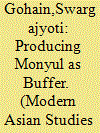

|
|
|
|
|
| Summary/Abstract |
This article focuses on the Tawang and West Kameng districts of Arunachal Pradesh, northeast India, collectively known as Monyul. It was ruled by Tibet for three centuries before the 1914 McMahon Line boundary included it in India. Even after that, cross-border exchanges between Monyul and Tibet continued until the 1962 Sino-Indian war, following which border passages between the two were closed. Today, Monyul is a marginal region, geographically distant from centres of industry and education, and lacking in terms of infrastructure. This article traces Monyul's marginality not simply to the border war, but to spatial practices of the British colonial state, beginning with the mapping of the boundary in 1914. It shows how Monyul was constructed as a buffer, despite being within a delimited boundary, first, by excluding it from regular administration, and, secondly, by pushing back the older Tibetan administration, thereby, making it (what I call) a ‘zone of difference/indifference’. But the buffer project was subject to contestation, mostly from the Tibetan religious aristocracy, whose temporal hold over, and material interests in, Monyul were challenged by the latter's incorporation into colonial India.
|
|
|
|
|
|
|
|
|
|
|
|
|
|
|
|
| 5 |
ID:
136298


|
|
|
|
|
| Summary/Abstract |
This article considers the way in which the ‘microphysics of power’ works on space and impacts on spatial politics. I focus on the transformation of one cantonment from a military garrison into a ‘residential barrack’: the Malir Cantonment in Karachi, Pakistan. The paper begins by tracing the history of cantonments, before locating the Malir Cantonment in the changing political, economic, and demographic dynamics of Karachi. Through this, the article focuses on the mechanisms through which Malir Cantonment functions as a residential barrack.
|
|
|
|
|
|
|
|
|
|
|
|
|
|
|
|
| 6 |
ID:
176476
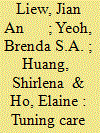

|
|
|
|
|
| Summary/Abstract |
The literature on care relations and eldercare has directed attention towards recognising the interdependence between ‘carer’ (familial caregiver or home support worker) and the ‘cared for’ (the older person). Such an approach gives attention to the contingencies and entanglements that shape the relationships among differently positioned members of care dyads. Drawing on in‐depth and ‘go‐along’ interviews, we examine how relations between migrant caregivers and their non‐migrant elderly charges in Singapore are spatially negotiated – formulated, sustained and reworked – on an everyday basis through Alfred Schütz's framework of intersubjective ‘tuning’. Owing to the unequal ways that migrant caregivers are positioned within Singapore society, moments of positive family‐like regard towards them are almost always preceded/superseded by forms of negativity and vice versa. The employer–employee care dyad is therefore best understood as a relational process that requires constant ‘tuning’, as the elderly employer needs care which no one else will provide, while the employee needs the job in order for the migration gamble to succeed. The paper concludes by drawing together the spatial and temporal insights that the conceptual approach of ‘tuning’ brings to analyses of care relations.
|
|
|
|
|
|
|
|
|
|
|
|
|
|
|
|
| 7 |
ID:
188238
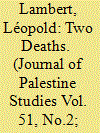

|
|
|
|
|
| Summary/Abstract |
In this essay, architect-activist and Funambulist editor-in-chief Léopold Lambert reflects on the ways that the architectural profession can be, and historically has been, complicit in structural injustice. He ties together the seemingly unrelated deaths of two men, uncovering in the process how architecture consecrates, amplifies, or abets oppression, be it in the settler-colonial context of occupied Palestine, in the French criminal justice system, or in the historical framework of the transatlantic slave trade.
|
|
|
|
|
|
|
|
|
|
|
|
|
|
|
|
|
|
|
|
|